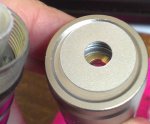I unscrewed the laser diode assembly to look at it again. Something I didn't expect to see - both of the laser pointers have a momentary contact switch mounted on the diode power supply board. I assume they bridged the switch contacts because the LPs are "on" whenever the circuit is complete - which is what the tail switch does. It just surprised me to see the extra parts - usually any Sino electronics I get are stripped to the barest minimum to make a circuit function.
Another thing I noticed while testing... both of the LPs have spacial filters a few mm outside the final lens. I didn't think about this when I got them - I assumed these were cosmetic stickers applied to make it "pretty". While examining the lens assy while illuminated, I noticed the large amount of illumination inside the stickers - then it hit me... this is to drop out some of the frequency artifacts in the beam by just blocking the noise and allowing the main beam through. One of the filters is off-center significantly. I considered removing them both, but I'll wait until I am ready to break the laser assy down. No sense making it harder to look at by introducing noise.
Another thing I noticed while testing... both of the LPs have spacial filters a few mm outside the final lens. I didn't think about this when I got them - I assumed these were cosmetic stickers applied to make it "pretty". While examining the lens assy while illuminated, I noticed the large amount of illumination inside the stickers - then it hit me... this is to drop out some of the frequency artifacts in the beam by just blocking the noise and allowing the main beam through. One of the filters is off-center significantly. I considered removing them both, but I'll wait until I am ready to break the laser assy down. No sense making it harder to look at by introducing noise.












